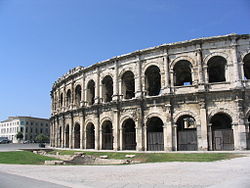Arena of Nîmes: Difference between revisions
m moved Arena of Nimes to Arena of Nîmes: wrong spelling |
No edit summary |
||
| Line 1: | Line 1: | ||
[[Image:Nimes amphi.jpg|thumb|right|250px|Exterior of the Arena of Nimes]] |
[[Image:Nimes amphi.jpg|thumb|right|250px|Exterior of the Arena of Nimes]] |
||
The '''Arena of |
The '''Arena of Nîmes''' is a [[Ancient Rome|Roman]] [[ampitheater]] found in the [[France|French]] city of [[Nîmes]]. Built in 27 B.C., it was remodeled in 1863 to serve as a [[bullring]]. The Arenas of Nimes is the site of two annual [[bullfight]]s, and it is also used for other public events. |
||
The building encloses an elliptical central space 133 [[metre|m]] long by 101 m wide. It is ringed by 34 rows of seats supported by a vaulted construction. It has a capacity of 16,300 spectators and since 1989 has a movable cover and a heating system. |
The building encloses an elliptical central space 133 [[metre|m]] long by 101 m wide. It is ringed by 34 rows of seats supported by a vaulted construction. It has a capacity of 16,300 spectators and since 1989 has a movable cover and a heating system. |
||
==History== |
==History== |
||
The Arena of |
The Arena of Nîmes was constructed in the time of Emperor [[Augustus]]. As the [[Roman Empire|Empire]] fell, the ampitheater was fortified by the [[Visigoths]] and surrounded by a wall. During the turbulent years that followed the collapse of Visigoth power in [[Hispania]] and [[Septimania]], not to mention the [[Islamic conquests|Muslim invasion]] and subsequent reconquest by the French kings in the early [[eighteenth century]], the [[viscount]]s of Nîmes constructed a fortified palace within the ampitheater. Later a small neighborhood developed within its confines, complete with one hundred denizens and two chapels. Seven hundred people lived within the ampitheater during the apex of its service as an enclosed community. |
||
The buildings remained in the ampithater until the eighteenth century, when the decision was made to convert the ampitheater into its present form. |
The buildings remained in the ampithater until the eighteenth century, when the decision was made to convert the ampitheater into its present form. |
||
Revision as of 18:38, 23 November 2006

The Arena of Nîmes is a Roman ampitheater found in the French city of Nîmes. Built in 27 B.C., it was remodeled in 1863 to serve as a bullring. The Arenas of Nimes is the site of two annual bullfights, and it is also used for other public events.
The building encloses an elliptical central space 133 m long by 101 m wide. It is ringed by 34 rows of seats supported by a vaulted construction. It has a capacity of 16,300 spectators and since 1989 has a movable cover and a heating system.
History
The Arena of Nîmes was constructed in the time of Emperor Augustus. As the Empire fell, the ampitheater was fortified by the Visigoths and surrounded by a wall. During the turbulent years that followed the collapse of Visigoth power in Hispania and Septimania, not to mention the Muslim invasion and subsequent reconquest by the French kings in the early eighteenth century, the viscounts of Nîmes constructed a fortified palace within the ampitheater. Later a small neighborhood developed within its confines, complete with one hundred denizens and two chapels. Seven hundred people lived within the ampitheater during the apex of its service as an enclosed community.
The buildings remained in the ampithater until the eighteenth century, when the decision was made to convert the ampitheater into its present form.
